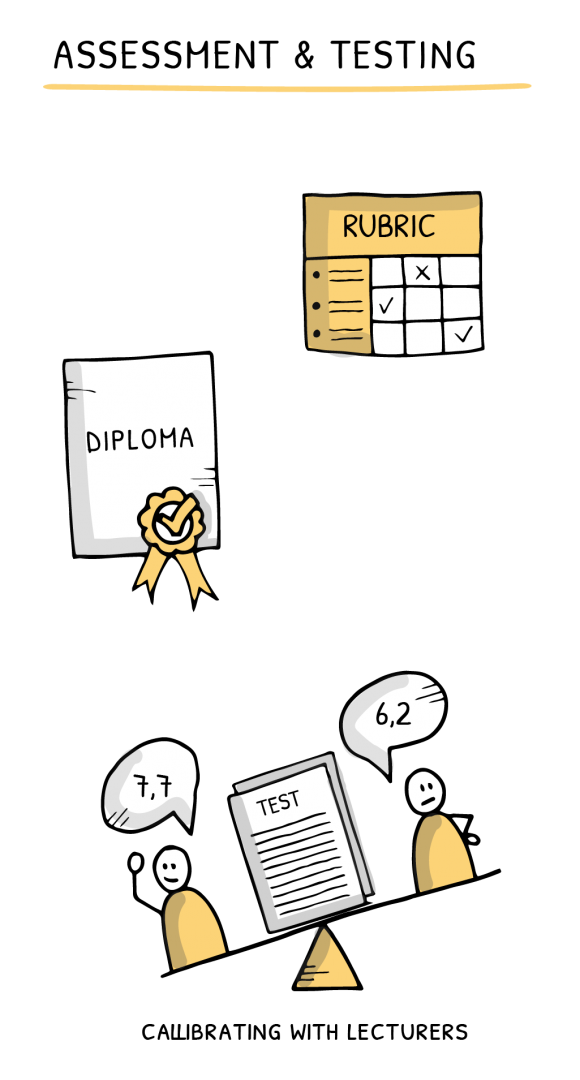Assessment and Testing
Safeguarding fair assessment
A student can demonstrate what they have learned through testing and assessment. But how do you make sure you develop a good quality test? How do you assess a student in an honest (objective) and reliable way? And how do you work together with your colleagues to develop a calibrated approach to assessment?
Why?
Why is objective assessment so important? Because students want to be tested in a way that corresponds to what they have learned and that is clearly defined in the course catalogue. Grades are a questionable measure of student competence. They are useful, however, as an objective, standardised measure for awarding certificates and qualifications. It is essential, therefore, that you evaluate your exams and the testing process continually throughout the course and the assessment process. This ensures that the assessments reliably reflect students’ knowledge at the time of assessment. It allows students to rely on the assessment of their knowledge that has taken place.
What?
It is hard to develop exams that are a fair and reliable reflection of students’ knowledge and skills. Especially when it is not just about the right answer but instead about students completing the assignments themselves. This type of situation can make evaluating objectively extra tricky. Fair assessments are reliable, transparent and valid and have a feedback function.
Read more about designing tests!
How?
In large degree programmes, courses are often taught and assessed by several lecturers. How do you ensure that all colleagues mark an exam in the same way, and how do you ensure the exam is fair in the first place?
Four-eyes principle (at least!) when creating the exam
Four-eyes principle (at least!) when creating the exam.
Always have someone read your exam: this relieves you of the pressure of trying to create a flawless exam. A fresh pair of eyes can help detect inconsistencies and improve the exam’s validity and reliability. Important to check:
- How does the test relate to the learning objectives? Do the content and level of the test match the course component?
- Are the questions clear and unambiguous?
- Does the exam match the course’s learning activities?
- Is the test sufficiently reflective of the material to be studied?
- Avoid spelling mistakes.
- Are any references to numbered appendices clear?
- A clear introduction page should state the date, the time available, resources allowed and anything else students will need for a stress-free assessment.
Four-eyes principle (at least!) when assessing
It is important for you as a lecturer not to be the only one assessing a student’s portfolio, assessment or graduation. You want to build an open and safe relationship with your students, in which they are allowed to make mistakes in order to learn (article). When students know you are also the person assessing them, this can make it harder to ask questions. In addition, objectivity and reliability are of great importance, especially with regard to modules that count for many credits (see also the scoring website).
The degree programme should have agreements in place on how the quality of assessments is safeguarded, for instance by a colleague with a Senior Examiner Qualification (SEQ) acting as first assessor and you or a colleague as second assessor.
Rubrics and assessment criteria
A rubric contains previously set criteria for measuring students’ achievements. It describes academic expectations and guidelines for students, thus bringing consistency to the assessment process.
Writing a rubric takes time, and it usually requires modification and calibration over the years. Rubrics are useful because they provide both students and lecturers with guidance regarding the module’s benchmarks. They indicate for each learning objective what skills and theory students must have acquired in order for their work to be assessed as satisfactory, good, excellent or unsatisfactory. Rubrics with four categories generally work better than rubrics with ten categories, as in the latter case, it tends to be hard to make the differences between levels objective. Good rubrics provide lecturers with a structure for oral exams or essay exams. Read more in the article ‘Designing tests’.
Did you know you can create rubrics directly in Brightspace? After having entered them, you can reuse them in different modules. They can also be linked to Gradebook. Read more about rubrics in Brightspace.
Calibration sessions between lecturers
When different lecturers teach the same course, care should be taken that their assessments are not too divergent. Calibration sessions with lecturers who teach the same course ensure a shared norm regarding what a 6 or an 8 stands for and help decide when students will get the maximum score for an answer. Clear guidelines such as rubrics are a vital part of every assessment and contribute to consistent scoring.
Evaluating your exam
Developing an exam is only the start. Regular critical evaluation of your exam is important to find out whether it works in your class. How an exam looks on paper and how it works in practice are two different matters.
A number of parameters can help you decide whether the assessment of your course needs improving. For example:
- Do your students consistently score high? This may mean the exam is too easy (or else that you have brilliant students).
- Do your students consistently score low or even fail the exam? Maybe it is too hard. This may also point to an unconstructive connection, meaning your exam is not a good fit for the course content and activities.
- Mind the details: Are there individual questions to which many students give a wrong answer or a right answer? Maybe those questions are too hard or too easy, respectively. Are there questions to which even students with high scores give a wrong answer? Maybe those questions are too hard.
If you recognise any of the above, it may be time to discuss with your colleagues how the exam might be modified.
Use the expertise of the Assessment Committee or the Examination Board

